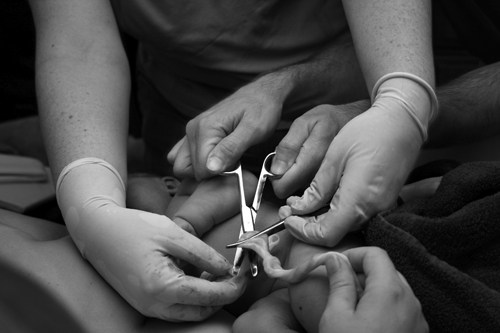What is Delayed Cord Clamping?
One notable difference between hospital and out of hospital birth is the time typically allowed for the infant to receive the placental blood supply before clamping and cutting the umbilical cord.
Approximately 30% of the baby’s blood remains in the placenta and cord at birth; immediately shutting off this source can deprive him of 60% of his red blood cells. This placental blood supply carries 40 to 50 mg of iron, helping prevent anemia and its attendant concerns in the newborn period. For this reason, the World Health Organization recommends late cord clamping at least one to three minutes after birth. Most home birth midwives, however, do not clamp the cord until it stops pulsing (typically at least 3 to 5 minutes) allowing the maximum amount of the baby’s own blood supply from the placenta to enter his body.
The American College of Obstetricians and Gynecologists (ACOG) now officially recommends “a delay in umbilical cord clamping for all healthy infants for at least 30-60 seconds after birth given the numerous benefits to most newborns.” Yet at 60 seconds there may still be quite a lot of blood volume that hasn’t transferred—it’s estimated that 70% of the placental supply has entered the baby at 120 seconds (or two minutes.)
Can delayed cord clamping cause any problems?
In the past it was hypothesized that all that extra blood could increase hyperbilirubinemia (physiologic jaundice) in the newborn, but experience has not borne this out and it is no longer considered an issue.
Are there instances when the cord should be clamped immediately?
Yes, but they are rare. One possible scenario would be a very tight cord preventing the baby from being born. Even when babies need help getting breathing going (resuscitation), experts believe it best to keep the cord intact so the baby is continuing to receive oxygenated blood from the placenta. Keeping his lifeline connected can only help as he makes the transition to the outside world.
So what typically happens in the hospital setting?
Many obstetricians are practicing “delayed” cord clamping of 1 minute. As explained above, though, this still shortchanges the baby. Also in many places the routine is for a nurse to move the infant to a radiant warmer immediately, stimulating and drying the baby at least several feet away from the mother’s body. Obviously this is much easier with the umbilical cord severed!
If you are planning a hospital birth, you may want to discuss with your doctor or midwife how long the cord may be left intact for your baby. If you are planning out of hospital birth, your midwife can explain what her practice is and why she holds that position.



